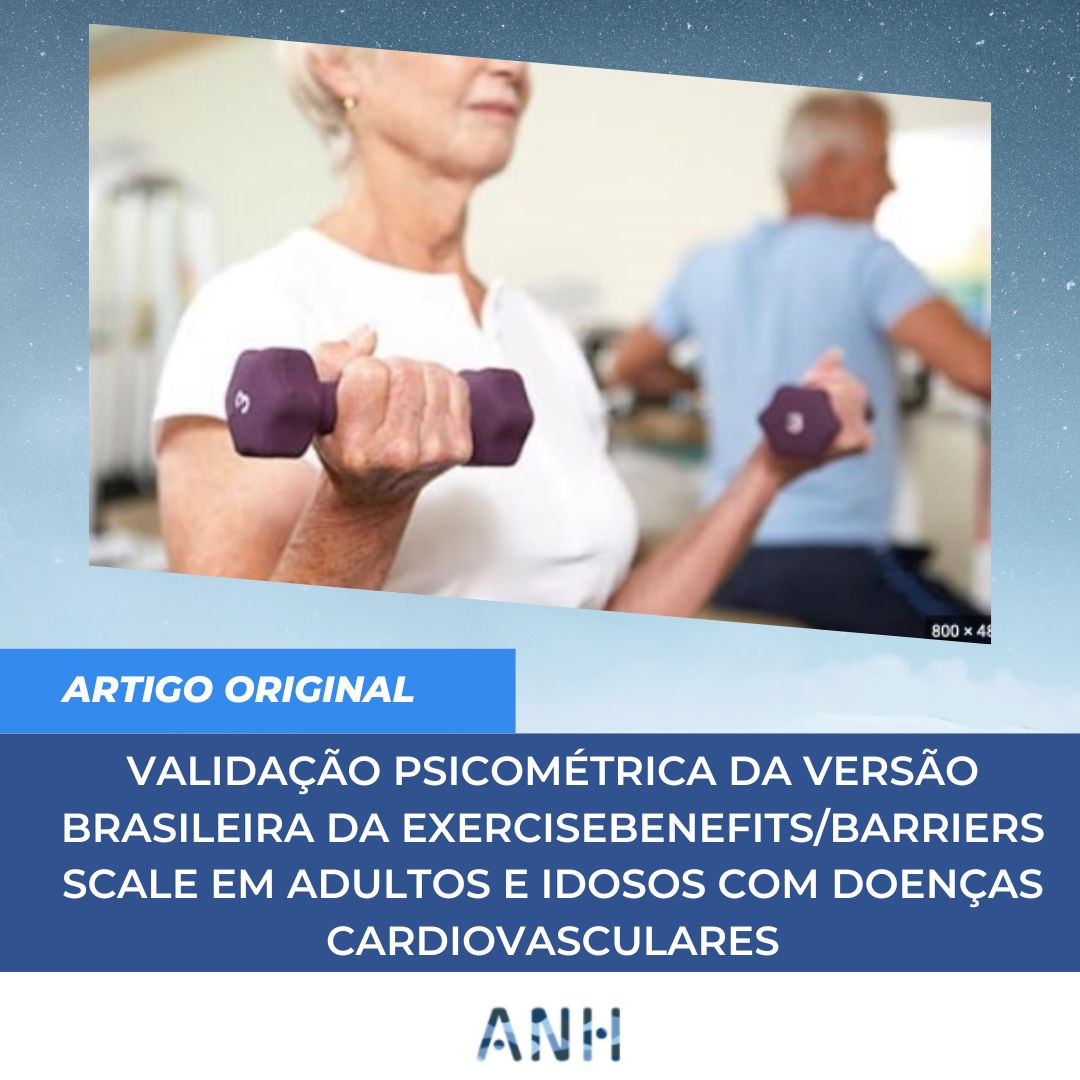Psychometric validity of the Exercise Benefits/Barriers Scale, Brazilian version, in adults and older adults with cardiovascular diseases
Psychometric validity of the Exercise Benefits/Barriers Scale, Brazilian version
DOI:
https://doi.org/10.5433/anh.2023v5.id46392Keywords:
Validation Study, Nursing Methodology Research, Exercise, Perception, Cardiovascular Diseases, PsychometricsAbstract
Objective: to describe the internal consistency and construct validity of the Exercise Benefits/Barriers Scale, Brazilian version, for adults and older adults with cardiovascular disease. Methods: this is a methodological study with 121 participants. The scale has 42 items divided into barriers (14 items) and benefits (28) subscales. The total score was between 42 and 168. Higher values indicate greater perception of benefits and lower perception of barriers to exercise. Internal consistency, construct validity (convergent and divergent) and the presence of ceiling and floor effects were described. Results: among the participants, 58.7% were male, with a mean age of 58.2 years (SD = 13.2) and low education (mean = 7.9 years; SD = 4.5). Cronbach's alpha values were 0.92 (total scale), 0.95 (benefits) and 0.65 (barriers). A negative and moderate linear correlation was verified between the total scores of the scale and the Cardiac Rehabilitation Barriers Scale (r=-0.513; p<0.001). Convergent and divergent validity were satisfactory according to multitrait-multimethod analysis. The presence of a ceiling effect was observed in 75% of benefits subscale items and a floor effect in item 12 of the barriers subscale. Conclusion: the instrument showed satisfactory internal consistency and construct validity in a sample of Brazilian adults and older adults with cardiovascular diseases. Future investigations are recommended with the performance of confirmatory factor analysis, assessing individuals with cardiovascular diseases, higher education, undergoing different therapeutic modalities and coming from different regions of the country.
Downloads
References
2. Roth GA, Johnson C, Abajobir A, Abd-Allah F, Abera SF, Abyu G, et al. Global, Regional, and National Burden of Cardiovascular Diseases for 10 Causes, 1990 to 2015. J Am Coll Cardiol [Internet]. 2017 Jul;70(1):1-25. Available from: https://linkinghub.elsevier.com/retrieve/pii/S0735109717372443
3. Shields GE, Wells A, Doherty P, Heagerty A, Buck D, Davies LM. Cost-effectiveness of cardiac rehabilitation: a systematic review. Heart [Internet]. 2018 Sep;104(17):1403-10. Available from: https://heart.bmj.com/lookup/doi/10.1136/heartjnl-2017-312809
4. Anderson L, Thompson DR, Oldridge N, Zwisler A-D, Rees K, Martin N, et al. Exercise-based cardiac rehabilitation for coronary heart disease. Cochrane Database Syst Rev [Internet]. 2016 Jan 5; Available from: https://doi.wiley.com/10.1002/14651858.CD001800.pub3
5. Dibben G, Faulkner J, Oldridge N, Rees K, Thompson DR, Zwisler A-D, et al. Exercise-based cardiac rehabilitation for coronary heart disease. Cochrane Database Syst Rev [Internet]. 2021 Nov 6;2021(11). Available from: http://doi.wiley.com/10.1002/14651858.CD001800.pub4
6. Rundle-Thiele S, Kubacki K, Gruneklee N. Perceived benefits and barriers of physical activity: A social marketing formative study. Health Mark Q [Internet]. 2016 Apr 2;33(2):181-94. Available from: http://www.tandfonline.com/doi/full/10.1080/07359683.2016.1166872
7. Victor JF, Ximenes LB, Almeida PC de. Reliability and validity of the Exercise Benefits/Barriers scale in the elderly. Acta Paul Enferm [Internet]. 2012;25(spe1):48-53. Available from: http://www.scielo.br/scielo.php?script=sci_arttext&pid=S0103-21002012000800008&lng=en&tlng=en
8. Shanmugasegaram S, Gagliese L, Oh P, Stewart DE, Brister SJ, Chan V, et al. Psychometric validation of the Cardiac Rehabilitation Barriers Scale. Clin Rehabil [Internet]. 2012 Feb 21;26(2):152-64. Available from: http://journals.sagepub.com/doi/10.1177/0269215511410579
9. Ghisi GL de M, Santos RZ dos, Schveitzer V, Barros AL, Recchia TL, Oh P, et al. Desenvolvimento e validação da versão em português da Escala de Barreiras para Reabilitação Cardíaca. Arq Bras Cardiol [Internet]. 2012 Apr;98(4):344-52. Available from: http://www.scielo.br/scielo.php?script=sci_arttext&pid=S0066-782X2012000400009&lng=pt&nrm=iso&tlng=en
10. Sechrist KR, Walker SN, Pender NJ. Development and psychometric evaluation of the exercise benefits/barriers scale. Res Nurs Health [Internet]. 1987 Dec;10(6):357-65. Available from: https://onlinelibrary.wiley.com/doi/10.1002/nur.4770100603
11. Victor JF, Ximenes LB, Almeida PC de. Adaptação transcultural para o Brasil da Exercise Benefits/Barriers Scale (EBBS) para aplicação em idosos: uma avaliação semântica. Cad Saude Publica [Internet]. 2008 Dec;24(12):2852-60. Available from: http://www.scielo.br/scielo.php?script=sci_arttext&pid=S0102 311X2008001200014&lng=pt&tlng=pt
12. Terwee CB, Bot SDM, de Boer MR, van der Windt DAWM, Knol DL, Dekker J, et al. Quality criteria were proposed for measurement properties of health status questionnaires. J Clin Epidemiol [Internet]. 2007 Jan;60(1):34-42. Available from: https://linkinghub.elsevier.com/retrieve/pii/S0895435606001740
13. Fayers PM, Machin D. Quality of Life: The assessment, analysis and reporting of patientâ€reported outcomes. 3rd ed. Vol. 1, John Wiley & Sons Inc. Wiley-Blackwell; 2016. 648 p.
14. Ware JE, Hayashi T, Hays RD. User's Guide for the Multitrait Analysis Program (MAP). Santa Monica: Rand Corporation; 1988. 37 p.
15. Lee S, Collins EG. Factors influencing physical activity after cardiac surgery: An integrative review. Hear Lung [Internet]. 2021 Jan;50(1):136-45. Available from: https://linkinghub.elsevier.com/retrieve/pii/S0147956320303952
16. Evangelista LS, Dracup K, Doering L, Moser DK, Kobashigawa J. Physical Activity Patterns in Heart Transplant Women. J Cardiovasc Nurs [Internet]. 2005 Sep;20(5):334-9. Available from: http://journals.lww.com/00005082-200509000-00007
17. Enríquez-Reyna MC, Cruz-Castruita RM, Zamarripa J, Ceballos-Gurrola O, Guevara-Valtier MC. Nivel de Actividad Física, Autoeficacia, Beneficios y Barreras Percibidas en Mujeres Mayores Mexicanas Independientes (Physical Activity Level, Exercise Self-Efficacy, Benefits and Perceived Barriers of Independent Mexican Older Women). Hisp Heal Care Int [Internet]. 2016 Mar 1;14(1):26-36. Available from: http://journals.sagepub.com/doi/10.1177/1540415316629680
18. Benjamin EJ, Muntner P, Alonso A, Bittencourt MS, Callaway CW, Carson AP, et al. Heart Disease and Stroke Statistics—2019 Update: A Report From the American Heart Association. Circulation [Internet]. 2019 Mar 5;139(10). Available from: https://www.ahajournals.org/doi/10.1161/CIR.0000000000000659
19. Sangster J, Furber S, Phongsavan P, Allman-Farinelli M, Redfern J, Bauman A. Where you live matters: Challenges and opportunities to address the urban-rural divide through innovative secondary cardiac rehabilitation programs. Aust J Rural Health [Internet]. 2013 Jun;21(3):170-7. Available from: https://onlinelibrary.wiley.com/doi/10.1111/ajr.12031
20. Cleary K, LaPier T, Rippee A. Perceptions of exercise and quality of life in older patients in the United States during the first year following coronary artery bypass surgery. Physiother Theory Pract [Internet]. 2015 Jul 4;31(5):337-46. Available from: http://www.tandfonline.com/doi/full/10.3109/09593985.2015.1004770
21. Enríquez-Reyna MC, Cruz-Castruita RM, Ceballos-Gurrola O, García-Cadena CH, Hernández-Cortés PL, Guevara-Valtier MC. Psychometric properties of the Exercise Benefits/Barriers Scale in Mexican elderly women. Rev Lat Am Enfermagem [Internet]. 2017 Jun 5;25. Available from: http://www.scielo.br/scielo.php?script=sci_arttext&pid=S0104-11692017000100349&lng=en&tlng=en
22. Akbari Kamrani AA, Zamani Sani SH, Fathire-Zaie Z, Bashiri M, Ahmadi E. The Psychometric Characteristics of the Exercise Benefits/Barriers Scale among Iranian Elderly. Iran J Public Health [Internet]. 2014 Mar;43(3):362-6. Available from: http://www.ncbi.nlm.nih.gov/pubmed/25988097
23. Akbari Kamrani AA, Zamani Sani SH, Fathi Rezaie Z, Bashiri M, Ahmadi E. Validity and reliability of the perceived benefits/ barriers scale of physical activity among Iranian elderly. J Research Health [Internet]. 2015 Sep 5(3):276-287. Available from: https://jrh.gmu.ac.ir/article-1-165-en.pdf.
24. Brown SA. Measuring Perceived Benefits and Perceived Barriers for Physical Activity. Am J Health Behav [Internet]. 2005 Mar 1;29(2):107-16. Available from: http://openurl.ingenta.com/content/xref?genre=article&issn=1087-3244&volume=29&issue=2&spage=107
25. Pasquali L. Psicometria. Rev da Esc Enferm da USP [Internet]. 2009 Dec;43(spe):992-9. Available from: http://www.scielo.br/scielo.php?script=sci_arttext&pid=S0080-62342009000500002&lng=pt&tlng=pt
26. Maindal HT, Sokolowski I, Vedsted P. Translation, adaptation and validation of the American short form Patient Activation Measure (PAM13) in a Danish version. BMC Public Health [Internet]. 2009 Dec 29;9(1):209. Available from: https://bmcpublichealth.biomedcentral.com/articles/10.1186/1471-2458-9-209

Downloads
Published
How to Cite
Issue
Section
License
Copyright (c) 2023 Advances in Nursing and Health

This work is licensed under a Creative Commons Attribution 4.0 International License.
All or the content of the newspaper is licensed under a Creative Commons Attribution License, of the CC-BY attribution type.
Authors retain the copyright, and authors are asked to indicate first publication in this journal in the event of republication. Articles published in Advances in Nursing and Health are licensed under the Creative Commons Attribution 4.0 International License, which ensures Open Access. This license allows any user to read, download, copy, and share the content, as long as it is properly cited. It also permits the reuse of the material, including its distribution, adaptation, and creation of derivative works in any format or medium, provided appropriate credit is given, a link to the license is provided, and any changes made are indicated. In addition, the license allows commercial use of the content.


















